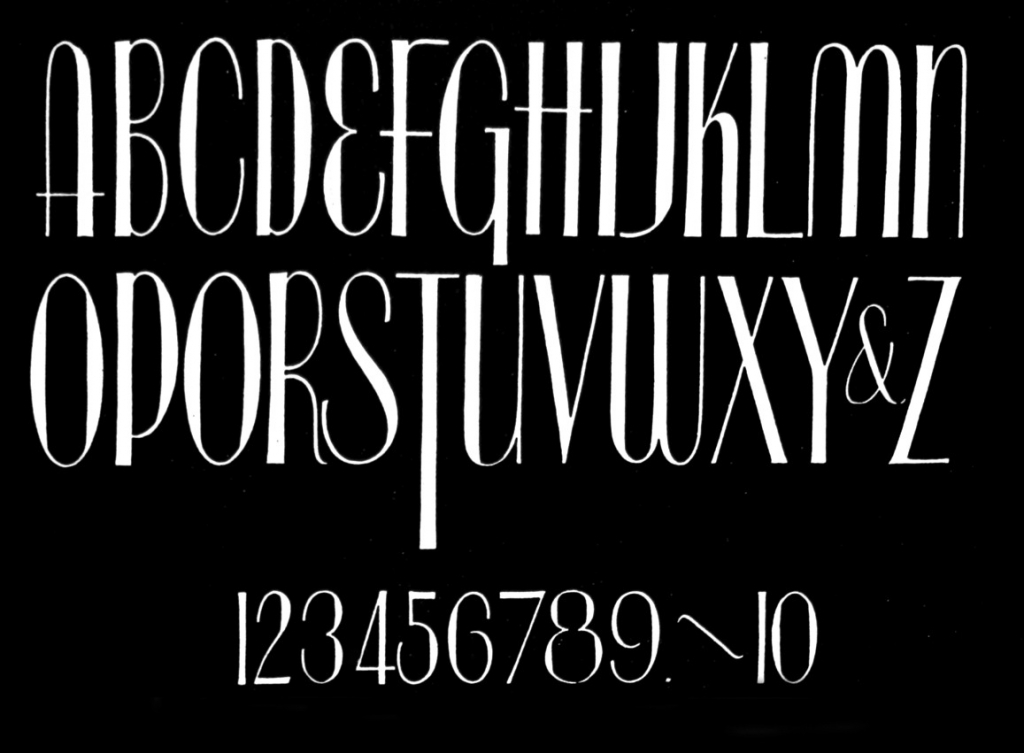Out of the blue, last September 4, Mike Adkins received an email from Preston Ordrop. Preston had been looking for a font for a friend’s T-shirt, and he stumbled on Mike’s website, www.thefontry.com. The Fontry sells fonts and alphabets that Mike has digitized. Preston subsequently contacted Mike to thank him because, also there, he’d found some Alf Becker digitized alphabets. Preston is Alf’s grandson.
People relatively new to the sign industry may not know Alf Becker is a bona fide sign-industry legend, having presented 320 monthly alphabets to ST readers from January 1932 until January 1959. Alf died March 10, 1959. As Tod Swormstedt reports on the American Sign Museum website, when editor E. Thomas Kelley initially approached Alf, he only envisioned a 24-alphabet, two-year run. Kelley died in January 1944, but Alf’s contribution wasn’t even halfway completed.
Preston was born in December 1959, so he never knew his grandfather, but, in his email to Mike, he said, “I have many of his original handwritten alphabets, along with magazine clippings he cut out where they were used. . . Unfortunately, none of his talent was passed on to me.”
Preston’s mother (Alf’s daughter) died in 1996, and he did inherit some of Alf’s non-sign work — oil paintings (which we will show next month). He’s heard talk that the boy in the Dutch Boy Paint logo was patterned after Alf’s painting, but he’s not sure.
“It really does look like his type and style of work, and I have an oil painting with several similarities to the Dutch Boy. I also have an oil painting of a boy feeding a candy cane to a collie that has similarities to the Dutch Boy,” the email stated.
Initially, of course, Mike couldn’t be sure that Preston was truly Alf’s grandson, but after having seen the oil paintings, Mike wrote, in an email, “It appears 100% legitimate, down to the images of original Becker oil paintings received in subsequent emails. The closeups of signatures matched exactly Becker’s crude method of signing things, as shown by his signature in one of the Becker pages.”
Meanwhile, Mike has digitized a couple dozen Becker alphabets, and half of those are commercially available. He began salvaging the Becker alphabets in 1998. However, he said he’s probably given away many more than he’s sold (along with Atkinson alphabets), and he makes most of his money off Greek (for fraternities and sororities) and script fonts.
Mike explained that no one “owns” fonts. Anyone who goes to the trouble of digitizing a font can subsequently sell it. Mike estimates maybe a dozen companies have digitized Becker alphabets, but he says he’s the only one who completely credits Alf and retains the original names. He credits Richmond, VA, signpainter Billy Pickett for having made copies of all 320 Becker alphabets.
In so doing, Billy also found a short biography on Alf on page 25 of ST’s February 1944 issue. It said Alf began painting signs in 1914. “He took lessons from Fletcher Seltzer, noted oil painter of St. Louis and California, and Gustav Wolf in New York. From 1926 to 1932, he taught commercial art and poster work at Roosevelt and Beaumont high schools in St. Louis, which was the first poster and sign-painting class ever organized in the St. Louis public schools,” ST reported.
Mike said these high schools still exist, but his efforts to find yearbooks that might have depicted Alf have been fruitless.
Preston has a folder with many clippings of those ST pages as well. But he only recently discovered them. Numerous boxes inherited from his mother had remained untouched in the attic. He recalls hearing that his grandfather painted signs in the St. Louis area, but that he also lived quite awhile in St. Petersburg, FL.
“I know that, during the Depression, he continued to make money, and I know he supported several families financially, who continued to be good friends with my mom as I was growing up. He literally saved several families, no question in my mind,” Preston wrote.
Unfortunately, no photos of Alf were apparently saved, Preston said. He wasn’t even aware of the alphabets until he was in his 20s. More vivid are the memories of eclectic art: “a coffee table with a glass top in the shape of an artist’s palette sat on legs of driftwood he collected on the beach. As a young boy, I remember the naked ladies, quite a few of them, lamps, glasses, etc. I always envisioned him as a Hemingway type.”
Indeed, Alf Becker’s standing in the sign community easily equates to that of “Papa” in literary circles. Look for photos of Alf’s oil paintings in the March 2010 issue.


 Tip Sheet4 days ago
Tip Sheet4 days ago
 Business Management2 weeks ago
Business Management2 weeks ago
 Women in Signs2 weeks ago
Women in Signs2 weeks ago
 Real Deal5 days ago
Real Deal5 days ago
 Benchmarks1 day ago
Benchmarks1 day ago
 Editor's Note1 week ago
Editor's Note1 week ago
 Line Time2 weeks ago
Line Time2 weeks ago
 Product Buying + Technology1 week ago
Product Buying + Technology1 week ago

















